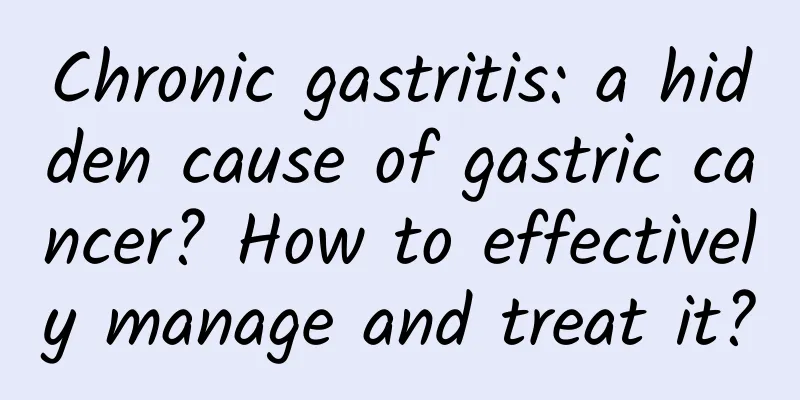Chronic gastritis: a hidden cause of gastric cancer? How to effectively manage and treat it?

|
Chronic gastritis is a common digestive system disease in my country. Studies have shown that the incidence of chronic gastritis in my country is on the rise, with an increase of 87.8% from 2003 to 2012. Another study shows that the prevalence of chronic gastritis diagnosed by endoscopy in my country is currently close to 90%. 1. Chronic gastritis is the main risk factor for gastric cancer Chronic gastritis is divided into chronic non-atrophic gastritis and chronic atrophic gastritis (CAG) according to whether there is mucosal atrophy under gastroscopy and pathology. The prevalence of chronic gastritis, especially CAG, generally increases with the patient's age, has little to do with gender, and has large differences between different countries and regions. The prevalence of gastritis in China and Japan is significantly higher than that in other countries, and is positively correlated with the incidence of gastric cancer. In the actual application of the gastric cancer screening process, the proportion of pathological states such as CAG and intraepithelial neoplasia (IN) confirmed by gastroscopy and pathological biopsy is as high as 30%. Correa et al. first proposed that the occurrence pattern of intestinal gastric cancer (accounting for more than 80% of gastric cancer) is normal gastric mucosa → chronic inflammation → atrophic gastritis → intestinal metaplasia → IN → gastric cancer, and believed that IN is a precancerous lesion of gastric cancer. A study in the Netherlands analyzed the endoscopic follow-up data of 22,365 patients over a five-year period and concluded that the annual incidence of gastric cancer in patients with gastric mucosal atrophy was 0.1%, the annual incidence of gastric cancer in patients with gastric mucosal atrophy combined with intestinal metaplasia was 0.25%, and the annual incidence of gastric cancer in patients with high-grade gastric intraepithelial neoplasia was 0.6%. Therefore, actively preventing and treating chronic gastritis is crucial to preventing gastric cancer. II. Endoscopic follow-up strategy for chronic gastritis Strengthening endoscopic follow-up is an important means to influence the prognosis of CAG. If the biopsy pathological results indicate mild atrophy, it is recommended that the patient undergo endoscopic and pathological follow-up once every 3 years. If there is a family history of gastric cancer, it is necessary to monitor once every 1 to 2 years; if moderate to severe atrophy with intestinal metaplasia has occurred, it is recommended to follow up once a year; if low-grade intraepithelial neoplasia occurs, especially moderate dysplasia, it is recommended to further examine the gastroscopy and increase the follow-up frequency to once every 6 months; if there is high-grade intraepithelial neoplasia, it is recommended to perform early endoscopic or surgical treatment immediately after diagnosis; autoimmune atrophic gastritis is persistently progressive, and endoscopic follow-up is recommended once every 3 years. Due to the large population base in my country, endoscopic and pathological examinations are difficult to use for large-scale screening, but non-invasive serological tests can be used to predict the prognosis of CAG, initially screen out people at high risk of cancer, and then conduct targeted endoscopic follow-up for high-risk people. Non-invasive detection methods include detecting serum pepsinogen I, serum pepsinogen II, and the ratio between the two, gastrin 17, serum Helicobacter pylori (H.pylori) antibodies, etc. Combined detection can be used to screen people at high risk of cancer. 3. Treatment strategies for chronic gastritis 1. Eradication of H.pylori is the primary measure for the treatment of CAG At present, H.pylori is considered to be the main cause of chronic active gastritis. After long-term or repeated infection, some patients may develop gastric mucosal atrophy, intestinal metaplasia, and even cancer. As early as 1994, the International Agency for Research on Cancer and the World Health Organization defined H.pylori as a Class I carcinogen. Almost all H.pylori infected people (including asymptomatic infected people confirmed by physical examination) have varying degrees of chronic active gastritis (i.e., H.pylori gastritis). H.pylori infection is the most important and controllable factor in the environmental factors for gastric cancer. Eradication of H.pylori can improve the inflammatory response of the gastric mucosa and delay or partially reverse gastric mucosal atrophy. The standard H. pylori eradication regimen is a bismuth quadruple regimen (proton pump inhibitor + bismuth + 2 antibiotics, treatment for 10 or 14 days). The 13C or 14C urea breath test should be repeated 4 weeks after the completion of eradication therapy to evaluate the effectiveness of eradication therapy. 2. Acid suppression therapy and symptomatic treatment The occurrence of chronic gastritis is related to gastric mucosal damage factors such as excessive gastric acid and pepsin or weakened gastric mucosal barrier function. The damage and protection mechanisms cannot achieve a dynamic balance, resulting in gastric mucosal damage. Therefore, inhibiting gastric acid and repairing gastric mucosa are the basic treatments for chronic gastritis. Currently, acid-suppressing drugs widely used in clinical practice include proton pump inhibitors, H2 receptor antagonists, and a new generation of acid-suppressing drugs, potassium ion competitive acid blockers, etc., which have significant effects on inhibiting gastric acid and improving symptoms. Gastric mucosal protective agents can strengthen the gastric mucosal barrier function and promote the healing of gastric mucosal erosions. They are generally used in combination with proton pump inhibitors. For patients with obvious anxiety and depression, when conventional treatment is ineffective or ineffective, antidepressants or antianxiety drugs can be added as remedial treatment, including tricyclic antidepressants or selective serotonin reuptake inhibitors. 3. Use of folic acid and traditional Chinese medicine preparations Previous studies have shown that folic acid treatment of gastric precancerous conditions can significantly increase the expression of the tumor suppressor gene p53 and decrease the expression of the Bcl-2 oncogene protein, that is, folic acid prevents gastric cancer by enhancing the apoptosis of epithelial cells in precancerous lesions. The "Chinese Consensus on Chronic Gastritis" points out that certain vitamins and trace elements such as selenium may reduce the risk of gastric cancer. For some people with low folic acid levels in the body, appropriate folic acid supplementation can improve the histological changes of CAG. In the consensus opinion on the diagnosis and treatment of CAG in traditional Chinese medicine, CAG is divided into six types: liver-stomach qi stagnation syndrome, liver-stomach stagnation heat syndrome, spleen-stomach deficiency syndrome, spleen-stomach damp-heat syndrome, stomach yin deficiency syndrome, and stomach collateral blood stasis syndrome. Chaihu Shugan San, Huagan Jian combined with Zuojin Wan, Huangqi Jianzhong Tang, Lianpu Yin, Yiguan Jian combined with Shaoyao Gancao Tang, Shixiao San combined with Danshen Yin are used for treatment respectively; Chinese patent medicines such as Wei Fuchun and Moluodan are mainly used to treat atrophic gastritis. 4. For low-grade gastric intraepithelial neoplasia with clear boundaries under endoscopy, endoscopic minimally invasive treatment can be considered Previous studies have shown that 38% to 75% of low-grade intraepithelial neoplasia will regress naturally, and 19% to 50% will persist. Among the cases that do not regress, 23% will progress to malignancy within 10 to 48 months. It has also been reported that the annual incidence of gastric adenocarcinoma in people with low-grade intraepithelial neoplasia is 0.6%. Therefore, endoscopic minimally invasive treatment can be considered for low-grade intraepithelial neoplasia of the gastric mucosa with clear boundaries under endoscopy. References [1] National Clinical Research Center for Digestive Diseases (Shanghai), National Alliance of Early Digestive Cancer Prevention and Control Centers, Helicobacter pylori Study Group of the Chinese Society of Gastroenterology, et al. Expert consensus on the management strategies of gastric mucosal precancerous conditions and precancerous lesions in China (2020) [J]. Chinese Journal of Digestion, 2020, 40(11): 731-741. [2] Fang Jingyuan, Zou Tianhui. Rethinking about chronic gastritis[J]. Chinese Journal of Digestion, 2021, 41(Z1): 12-16. [3] Helicobacter pylori Study Group of the Chinese Society of Gastroenterology. Report on the Sixth National Consensus on the Management of Helicobacter pylori Infection (Non-Eradication Therapy Part)[J]. Chinese Journal of Gastroenterology, 2022, 42(05): 289-303. |
Recommend
3 ways to improve user retention through APP operation!
With the disappearance of the Internet's demo...
Mooncake trivia | Can you believe it? Fruit mooncakes are actually made of winter melon!
According to GB/T19855-2023 "General Rules f...
Crowdfunding is not lending: just talking about money is not enough
Recently, the popularity of crowdfunding has exce...
How much does it cost to develop a shopping mall mini program in Liaocheng?
There is no fixed price for the development of th...
Xigua Video Product Analysis Report
Watching videos in free time has become an entert...
How much does it cost for Jinchang to be an agent for a voting mini program?
How much does it cost to be an agent of Jinchang ...
Little Red Book Promotion Notes Marketing Strategy!
If you ask me which platform users enjoy watching...
Why is the “Hua Xizi” IP marketing so popular?
At present, people born in the 1990s and 1995s ha...
Bidding account hosting outsourcing, how can enterprises do bidding well and avoid detours?
How to choose a bidding hosting company? If the c...
How much does it cost to customize the Baoji kitchen mini program? What is the price for customizing Baoji Kitchen Mini Program?
What is the price for customizing Baoji Kitchen M...
How much does it cost to join a book mini program in Tongchuan?
Is it easy to join the Tongchuan Book Mini Progra...
Green Slim Weight Loss: How does Chongqing website optimization benefit internal links?
A good ranking for a website has a lot to do with...
Methodology: Use the idea of creating a "hot product" to operate content
When doing content operations , most people hope ...
User Growth: Why isn’t your user base growing?
The changes of the times and channels will bring ...
The "diving" cooling is coming! Doctors remind you to protect these 5 parts of your body!
Some time ago, the temperature soared in many pla...









